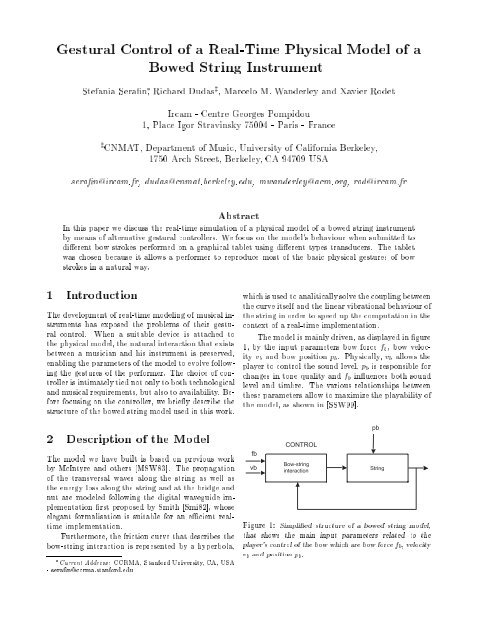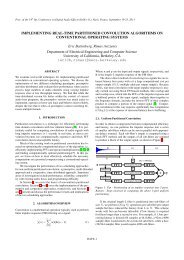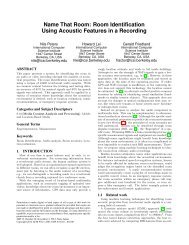Gestural Control of a Real-Time Physical Model of a Bowed String ...
Gestural Control of a Real-Time Physical Model of a Bowed String ...
Gestural Control of a Real-Time Physical Model of a Bowed String ...
You also want an ePaper? Increase the reach of your titles
YUMPU automatically turns print PDFs into web optimized ePapers that Google loves.
<strong>Gestural</strong> <strong>Control</strong> <strong>of</strong> a <strong>Real</strong>-<strong>Time</strong> <strong>Physical</strong> <strong>Model</strong> <strong>of</strong> a<br />
<strong>Bowed</strong> <strong>String</strong> Instrument<br />
Stefania Seran , Richard Dudas z , Marcelo M. Wanderley and Xavier Rodet<br />
Ircam - Centre Georges Pompidou<br />
1, Place Igor Stravinsky 75004 - Paris - France<br />
z<br />
CNMAT, Department <strong>of</strong> Music, University <strong>of</strong> California Berkeley,<br />
1750 Arch Street, Berkeley, CA 94709 USA<br />
seran@ircam.fr, dudas@cnmat.berkeley.edu, mwanderley@acm.org, rod@ircam.fr<br />
Abstract<br />
In this paper we discuss the real-time simulation <strong>of</strong> a physical model <strong>of</strong> a bowed string instrument<br />
by means <strong>of</strong> alternative gestural controllers. We focus on the model's behaviour when submitted to<br />
dierent bow strokes performed on a graphical tablet using dierent types transducers. The tablet<br />
was chosen because it allows a performer to reproduce most <strong>of</strong> the basic physical gestures <strong>of</strong> bow<br />
strokes in a natural way.<br />
1 Introduction<br />
The development <strong>of</strong> real-time modeling <strong>of</strong> musical instruments<br />
has exposed the problems <strong>of</strong> their gestural<br />
control. When a suitable device is attached to<br />
the physical model, the natural interaction that exists<br />
between a musician and his instrument is preserved,<br />
enabling the parameters <strong>of</strong> the model to evolve following<br />
the gestures <strong>of</strong> the performer. The choice <strong>of</strong> controller<br />
is intimately tied not only to both technological<br />
and musical requirements, but also to availability. Before<br />
focusing on the controller, we briey describe the<br />
structure <strong>of</strong> the bowed string model used in this work.<br />
2 Description <strong>of</strong> the <strong>Model</strong><br />
The model we have built is based on previous work<br />
by McIntyre and others [MSW83]. The propagation<br />
<strong>of</strong> the transversal waves along the string as well as<br />
the energy loss along the string and at the bridge and<br />
nut are modeled following the digital waveguide implementation<br />
rst proposed by Smith [Smi82], whose<br />
elegant formalisation is suitable for an ecient realtime<br />
implementation.<br />
Furthermore, the friction curve that describes the<br />
bow-string interaction is represented by ahyperbola,<br />
Current Address:<br />
CCRMA, Stanford University, CA, USA<br />
- seran@ccrma.stanford.edu<br />
which is used to analitically solve the coupling between<br />
the curve itself and the linear vibrational behaviour <strong>of</strong><br />
the string in order to speed up the computation in the<br />
context <strong>of</strong> a real-time implementation.<br />
The model is mainly driven, as displayed in gure<br />
1, by the input parameters bow force f b ,bowvelocity<br />
v b and bow position p b . <strong>Physical</strong>ly, v b allows the<br />
player to control the sound level, p b is responsible for<br />
changes in tone quality and f b inuences both sound<br />
level and timbre. The various relationships between<br />
these parameters allow to maximize the playability <strong>of</strong><br />
the model, as shown in [SSW99].<br />
fb<br />
vb<br />
CONTROL<br />
Bow-string<br />
interaction<br />
pb<br />
<strong>String</strong><br />
Figure 1: Simplied structure <strong>of</strong> a bowed string model,<br />
that shows the main input parameters related to the<br />
player's control <strong>of</strong> the bow which arebow force f b,velocity<br />
v b and position p b.
3 Bow Strokes<br />
The aim <strong>of</strong> our project is the real-time simulation <strong>of</strong><br />
highly skilled bowed string instrument performance.<br />
In particular, we are interested in studying the model's<br />
behaviour, when submitted to dierent bowstrokes,<br />
such asdetache, balzato, staccato, ying staccato ....<br />
The basic gestural parameters which can be used<br />
to dene bow strokes are: a specic precision grip in<br />
which all ve ngers are in contact with the bow, a<br />
variable length linear displacement in the axis <strong>of</strong> the<br />
bow, a rotational movement relative to the strings'<br />
axes in order to choose the string to be played,the<br />
pressure <strong>of</strong> the bow against the string and the bow<br />
velocity. Other important variables include the bow<br />
position relative to the string and the amount <strong>of</strong>bow<br />
hair in contact with the string, i.e., a rotation with<br />
respect to the bow's axis.<br />
One must also be aware that the technical demands<br />
required to preform many <strong>of</strong> these bow strokes<br />
are typically obtained by musicians only after years <strong>of</strong><br />
practice. Furthermore, in addition to the performer's<br />
skilled motor behaviour, these bow strokes heavily rely<br />
upon physical properties <strong>of</strong> both the string and the<br />
bow, such as the elasticity <strong>of</strong>thebow hair, tension <strong>of</strong><br />
the string, etc . . . .<br />
4 Choice <strong>of</strong> the Input <strong>Control</strong>ler<br />
In order to obtain an accurate simulation <strong>of</strong> the bow<br />
strokes mentioned above, it is necessary to haveaexible<br />
input controller at one's disposition. We have<br />
therefore decided to use an input device that provides<br />
both the means to reproduce the fundamental characteristics<br />
<strong>of</strong> the performer's gestural control and which<br />
is suciently generic in order to be able to extrapolate<br />
the typical violin technique. Other important considerations<br />
for our choice <strong>of</strong> input device were availability,<br />
accuracy, precision, resolution and aordability.<br />
Among the commonly available standard input<br />
devices that match the above requirements, the one<br />
that appeared to best suit our needs was a WA-<br />
COM graphic tablet equipped with a stylus transducer.<br />
One <strong>of</strong> the main factors in our decision was the<br />
number <strong>of</strong> control parameters simultaneously available<br />
[WWF97]. More specically, thestylus can provide<br />
control for ve variables: horizontal and vertical position<br />
in a plane, pressure perpendicular to the plane,<br />
and angle relative to both plane axes.<br />
The stylus is then used to control bow force, bow<br />
velocity, distance from the bridge and inclination <strong>of</strong><br />
the bow. One can notice from gure 2 [CMR91] and3<br />
that the stylus provides roughly the same control possibilities<br />
as those <strong>of</strong> a real bow, and that there is also<br />
Figure 2: Stylus, puck and extra sensors depicted in terms<br />
<strong>of</strong> the types <strong>of</strong> variables sensed and resolution.<br />
a direct correspondance between the physical parameters<br />
<strong>of</strong> the stylus and those <strong>of</strong> the bow (e.g. position<br />
in x and y axis, force in the z axis and angle in both<br />
x and y). In addition, the stylus' attributes can be<br />
considered as integral, and thus match the perceived<br />
manipulation task (bow manipulation) [JSMM94].<br />
4.1 Extending the Tablets Capabilities<br />
The ability to use two devices on the same tablet simultaneously<br />
seems optimal for simulating both hands<br />
<strong>of</strong> a bowed string instrument's player. This allows the<br />
performer to control bowing with one hand, while controlling<br />
pitch changes, vibrati and glissandi with the<br />
other, either using a second stylus or a puck transducer.<br />
After experiments with both devices, we noticed<br />
that the fact that they do not provide the physical interaction<br />
that exists between the nger and the string<br />
restrains optimal control. We coped with this problem<br />
by tting the tablet with sensors that can measure position<br />
and force simultaneously. These are shown in<br />
gure 4.<br />
Although positioning these sensors on the tablet<br />
does not provide the same tactile feedback as the ngerboard<br />
<strong>of</strong> a violin or other stringed instrument, the<br />
left hand nger position and pressure on a string <strong>of</strong><br />
a real instrument may nonetheless be simulated. The<br />
main advantage in using these extra sensors is that,<br />
when compared to a stylus or a puck, they are operated<br />
using similar motor skills.<br />
5 Use <strong>of</strong> the tablet<br />
We extended the musical programming environment<br />
Max/MSP [Zic98] by writing a DSP code resource,<br />
called violin ,which implements a physical model <strong>of</strong> a
fb [N]<br />
vb [m/s]<br />
STYLUS-TABLET<br />
BOW-VIOLIN<br />
1<br />
2<br />
Y POSITION ON THE<br />
TABLET<br />
DERIVATIVE OF THE<br />
X POSITION<br />
BOW POSITION<br />
BOW VELOCITY<br />
3<br />
Z POSITION<br />
BOW PRESSURE<br />
4<br />
ANGLE IN THE X AXIS<br />
STRING PLAYED<br />
5<br />
ANGLE IN THE Y AXIS<br />
AMOUNT OF BOW<br />
HAIR<br />
NUT<br />
5<br />
2<br />
3<br />
4<br />
1<br />
BRIDGE<br />
Figure 3: Comparison between the degrees <strong>of</strong> freedom <strong>of</strong><br />
the bow-string and the ones <strong>of</strong> the pen-tablet interaction.<br />
bowed string instrument. Although the object's name<br />
is \violin", it can be nonetheless be modied to model<br />
other stringed instruments. A second external code<br />
resource called wacom (written initally in 1996 by one<br />
<strong>of</strong> the authors, but updated for this project in order<br />
to accomodate the latest features <strong>of</strong> the current series<br />
<strong>of</strong> WACOM graphic tablets), is used to detect and<br />
output the parameters <strong>of</strong> the transducer(s) on a tablet.<br />
The values provided by the stylus-tablet interaction<br />
are detected by the wacom object which sends them<br />
as input parameters to the violin object.<br />
6 Simulation <strong>of</strong> Bow Strokes<br />
Using the stylus, we are able to reproduce most <strong>of</strong><br />
the bow strokes (such as staccato, balzato, martellato<br />
. . . ) without resorting to any special non-linear<br />
mapping <strong>of</strong> stylus output parameters to model input<br />
parameters. In particular, even bow strokes obtained<br />
by skilled musicians can be reproduced immediately<br />
and intuitively from the use <strong>of</strong> the stylus in place <strong>of</strong><br />
abow. For example, to obtain a balzato the player<br />
rubs the string quickly with the bow backward and<br />
forward, \jumping" on the string using both his wrist<br />
and his forearm, and taking advantage <strong>of</strong> the elasticity<br />
<strong>of</strong> both the string and the bow ([SD99])<br />
In order to examine the behavior <strong>of</strong> the model<br />
when submitted to fast repeated balzatos, the player<br />
1<br />
3<br />
2<br />
4<br />
5<br />
Figure 4: WACOM tablet tted with additional pressure<br />
and position sensors (on the left side <strong>of</strong> the tablet).<br />
simply needs to rub the tablet with the pen backward<br />
and forward and then release it. The evolution <strong>of</strong> the<br />
resulting parameters, shown in gure 5, corresponds<br />
to measurements made by Askenfelt ([Ask86]) on an<br />
actual violin.<br />
0.5<br />
0.25<br />
1<br />
0.5<br />
0 0.5 1<br />
<strong>Time</strong> (sec)<br />
0 0.5 1 <strong>Time</strong> (sec)<br />
Figure 5: Top: pressure <strong>of</strong> the stylus on the tablet during<br />
balzato. Bottom: velocity <strong>of</strong> the pen.<br />
Note that in this bow stroke, while the hand that<br />
holds the stylus reproduces with delitythemovement<br />
performed using a bow, the behaviour <strong>of</strong> the controller<br />
is quite dierent. An important characteristic <strong>of</strong> the<br />
balzato stroke is the fact that the player takes advantage<br />
<strong>of</strong> the elasticity <strong>of</strong> both the string and the bow<br />
hair to facilitate the bouncing <strong>of</strong> the bow. Since this<br />
elasticity is absent in both the tablet and stylus, the<br />
performer must use a slightly modied gesture in order<br />
to furnish all the energy necessary for the stylus to<br />
rebound. A similar situation is observed in other bow<br />
strokes that are completely based on physical properties<br />
<strong>of</strong> the instrument, the more remarkable example<br />
<strong>of</strong> which isthegettato. In it the player simply allows<br />
the bow to fall and freely rebound against the string.<br />
The rigid surfaces <strong>of</strong> the tablet and <strong>of</strong> the stylus do not
vb [m/s]<br />
fb [N]<br />
vb [m/s]<br />
fb [N]<br />
provide the same elastic feedback feltby the violinist.<br />
The bow strokes shown so far have the common<br />
characteristic that the bow is not in constant contact<br />
with the string, which is not always the case with other<br />
bow strokes. For example, to play detache the stylus<br />
simply moves back and forth along the horizontal axis<br />
<strong>of</strong> the tablet, at an almost constant velocity and pressure,<br />
as shown in gure 6. Another example would be<br />
staccato, inwhich the performer exerts a high initial<br />
force and velocity and then stops the stylus almost<br />
immediately, as can be seen in gure 7.<br />
It is remarkable that, while learning to hold a bow<br />
and perform skilled bow strokes requires a considerable<br />
amount <strong>of</strong> time, the familiarity with a device like<br />
a pen allows the performer to obtain immediately a<br />
condentiality with the controller.<br />
0.5<br />
0.25<br />
1<br />
0.5<br />
0<br />
0<br />
2 3<br />
1 2 3<br />
<strong>Time</strong> (sec)<br />
<strong>Time</strong> (sec)<br />
Figure 6: Top: pressure <strong>of</strong> the stylus on the tablet during<br />
detache. Bottom: velocity <strong>of</strong>thestylus.<br />
0.5<br />
0.25<br />
0 0.5 1<br />
1<br />
0.5<br />
<strong>Time</strong> (sec)<br />
also like to thank Patrice Pierrot for his dedicated<br />
work on the additional \left hand" sensor.<br />
References<br />
[Ask86]<br />
[CMR91]<br />
A. Askenfelt. Measurement <strong>of</strong>bow motion and<br />
bow force in violin playing. JASA, 80(4):1007{<br />
1015, october 1986.<br />
S. K. Card, J. D. Mackinlay, and G. G. Robertson.<br />
A morphological analysis <strong>of</strong> the design<br />
space <strong>of</strong> input devices. In ACM Trans. Inf.<br />
Syst, volume 9, apr. 1991.<br />
[JSMM94] R. J. K. Jacob, L. E. Sibert, D. C. Mcfarlane,<br />
and M. P. Mullen. Integrability and<br />
separability <strong>of</strong> input devices. ACM Transactions<br />
on Human-Computer Interaction, 1(1):3{<br />
26, March 1994.<br />
[MSW83] M. E. McIntyre, R. T. Schumacher, and<br />
J. Woodhouse. On the oscillations <strong>of</strong> musical<br />
instruments. JASA, 74:1325{1345, 1983.<br />
[SD99]<br />
[Smi82]<br />
[SSW99]<br />
S. Seran and R. Dudas. An Alternative <strong>Control</strong>ler<br />
for a Virtual <strong>Bowed</strong> <strong>String</strong> Instrument.<br />
1999. in Trends in <strong>Gestural</strong> <strong>Control</strong> <strong>of</strong> Music,<br />
M. Wanderley, M. Battier and J. Rovan, eds.,<br />
IRCAM, 1999.<br />
J. O. Smith. Synthesis <strong>of</strong> bowed strings. In Proceedings<br />
<strong>of</strong> the International Computer Music<br />
Conference (ICMC), Venice, Italy, 1982. Computer<br />
Music Association.<br />
S. Seran, J. O. Smith, and J. Woodhouse. An<br />
investigation <strong>of</strong> the impact <strong>of</strong> torsion waves and<br />
friction characteristics on the playability <strong>of</strong> virtual<br />
bowed strings. In to appear in Proceedings<br />
<strong>of</strong> the 1999 IEEE WASPAA, 1999.<br />
[WWF97] M. Wright, D. Wessel, and A. Freed. New<br />
musical structures from standard gestural controllers.<br />
In Proceedings <strong>of</strong> the International<br />
Computer Music Conference (ICMC), Thessaloniki,<br />
1997. Computer Music Association.<br />
[Zic98]<br />
D. D. Zicarelli. An extensible real-time signal<br />
processing environment for Max. In Proceedings<br />
<strong>of</strong> the International Computer Music Conference<br />
(ICMC), Ann Arbor, Michigan, 1998.<br />
Computer Music Association.<br />
0 0.5 1<br />
<strong>Time</strong> (sec)<br />
Figure 7: Top: pressure <strong>of</strong> the stylus on the tablet during<br />
staccato. Bottom: velocity <strong>of</strong>thestylus.<br />
7 Acknowledgments<br />
The authors would like to thank David Wessel and the<br />
France Berkeley Fund (Project Title: <strong>Gestural</strong> <strong>Control</strong><br />
<strong>of</strong> Musical Sound Synthesis), for providing the<br />
tablet used for the simulations. The authors would





